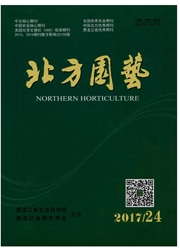

 中文摘要:
中文摘要:
为了探明不同氮钾肥用量对番茄根际土壤细菌群落及土壤养分和盐分的影响,以番茄为研究对象,设置不同氮肥和钾肥用量,通过土培盆栽模拟试验,利用高通量测序技术测定根际土壤微生物及土壤养分的变化。结果表明:1)施肥使主要的优势菌群发生明显改变,过量施肥显著降低根际土壤的细菌数量,根际土壤中肠杆菌科(Enterobacteriaceae)细菌的相对丰度明显下降,但鞘脂单胞菌科(Sphingomonadaceae)和黄单胞菌科(Xanthomonadaceae)相对丰度略有增加,细菌种群分布趋于单一化。2)过量施肥导致的土壤电导率(EC)增加、C/N下降,是土壤根际细菌群落发生改变的主要原因。3)过量施肥显著降低番茄株高、茎粗,但叶片叶绿素SPAD相对含量却呈现增加趋势,叶片光合作用受到抑制,从而产量明显下降。研究表明,施肥过量是导致设施土壤次生盐渍化的主要因素,次生盐渍化导致土壤中细菌群落发生改变,植株生长受到抑制,从而产量下降。
 英文摘要:
英文摘要:
In order to investigate the influence of different nitrogenous and potassium fertilizers on soil bacterial community and soil nutrient and salt changes in tomato rhizosphere soil.Tomato was used as test object,different dosage of nitrogenous and potassium were set,with indoor pot simulation tests using high-throughput sequencing methods,the change of the soil bacterial community and soil nutrient and salt were studied.The results showed that,1)Fertilization significantly changed the dominant microorganisms,high fertilization significantly reduced the number and species of bacteria in the soil.In the dominant microorganisms Enterobacteriaceae relative abundance significantly reduced,Sphingomonadaceae and Xanthomonadaceae relative abundance slightly increased.The dominant microorganisms tended to be single.2)High fertilization significantly increased the soil conductivity(EC)and decreased the soil C/N,was the main reason for the change of the soil the dominant microorganisms.3)High fertilization significantly decreased the plant height and diameter but significantly increased SPAD.High fertilization led to the inhibition of leaf photosynthesis,resulting in a significant decline in yield.The results showed that high fertilization was the main factor leading to the secondary salinization of the soil,and the secondary salinization led to the change of the bacterial community in the soil,and the secondary salinization led to the inhibition of leaf photosynthesis,resulting in a significant decline in yield.
 同期刊论文项目
同期刊论文项目
 同项目期刊论文
同项目期刊论文
 期刊信息
期刊信息
